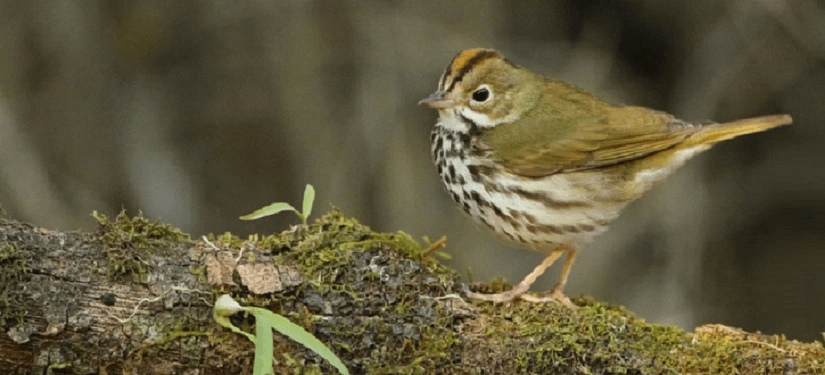Featured Data
Calling Activity of Birds in the White Mountain National Forest: Audio Recordings (2016 and 2018)
September 1, 2021
Susanne Grossman-Clarke
Citation
Symes, L.B., K.D. Kittelberger, S.M. Stone, R.T. Holmes, J.S. Ralston, I.P. Casteneda Ruvalcaba, M.S. Webster, and M.P. Ayres. 2021. Calling activity of Birds in the White Mountain National Forest: Audio Recordings (2016 and 2018) ver 3. Environmental Data Initiative. https://doi.org/10.6073/pasta/efba421dc87e077ee28010069dac7c0d
Description

The audio recordings of migratory song birds published in this data package were gathered in the USDA Forest Service’s Hubbard Brook Experimental Forest, a 7,800-acre northern hardwood forest in the White Mountain National Forest in New Hampshire. The experimental forest was established in 1955 and is renowned as the first site where water samples indicating acid rain were collected. This discovery was instrumental in the development of the Clean Air Act. Collaborative, multidisciplinary research efforts on air, water, soils, plants, and animals are carried out here by the Hubbard Brook Ecosystem Study (HBES). HBES is a public-private partnership of the USDA Forest Service, the National Science Foundation’s Long Term Ecological Research (LTER) program, the Hubbard Brook Research Foundation and scientists around the world. HBES was founded in 1963 and is one of the longest running and most comprehensive ecosystem studies in the world.

Lead author of the data package, Laurel Braden Symes (Assistant Director of the K. Lisa Yang Center for Conservation Bioacoustics at Cornell University) and colleagues collected more than 400 10-minute sound recordings of birds in and near Hubbard Brook Experimental Forest during their breeding season. The data set includes 130,776 vocalizations from 46 taxa over a period of two years. In addition to the recordings, the data package also includes analyses of habitat associations, phenology, and spatial patterning in vocalization activity.
The design of this data package follows EDI’s data package best practices guidelines for special data, as established by a working group of LTER information managers and members of EDI (Gries et al. 2021), among them Mary Martin, Information Manager for HBES. Instructions on how to work with audio files can be found under the “Images and Documents as Data” section of the guidelines. Information and considerations are provided on data package structure and documentation as well as an inventory table which serves as a document catalog. Mary prepared the audio recordings for publication in the EDI data repository.
You can listen to an audio file from June 2018 at the Middle Hubbard Brook location on Soundcloud: https://soundcloud.com/hubbard-brook/m01rec010040/s-LA5LCAY0WoH, with vocalizations of the black-throated blue warbler, black-throated green warbler, ovenbird, red-eyed vireo, scarlet tanager and yellow-bellied sapsucker. The data collection was also featured in a story of the New Hampshire Public Radio Station (NHPR): https://www.nhpr.org/climate-change/2021-02-04/pandemic-sparks-innovation-at-n-h-s-influential-hubbard-brook-experimental-forest.

These recordings contribute to studying the effects of climate change on the timing of migratory song birds’ return from the tropics, species richness and diversity. There are advantages of acoustic data collection in comparison with human observations. For example, audio systems can be in place to record spring arrivals when snow prevents access by researchers to the forest sites.
In addition, long-term observations of bird populations at Hubbard Brook, which were carried out for over 50 years, provide insights to studies on declining bird populations at the continental scale as reported in Science by Rosenberg et al. (2019). At the local Hubbard Brook scale bird populations appear healthy. Changes in bird population here are driven by forest aging, rather than habitat loss, pesticides, building collisions, and more, as can be the case at larger scales.
References
Rosenberg KV, Dokter AM, Blancher PJ, Sauer JR, Smith AC, Smith PA, Stanton JC, Panjabi A, Helft L, Parr M and PP Marra (2019): Decline of the North American avifauna. Science 366, 120-124, DOI: 10.1126/science.aaw1313.
Gries, C., S. Beaulieu, R.F. Brown, S. Elmendorf, H. Garritt, G. Gastil-Buhl, H. Hsieh, L. Kui, M. Martin, G. Maurer, A.T. Nguyen, J.H. Porter, A. Sapp, M. Servilla, and T.L. Whiteaker. 2021. Data Package Design for Special Cases ver 1. Environmental Data Initiative. https://doi.org/10.6073/pasta/9d4c803578c3fbcb45fc23f13124d052.